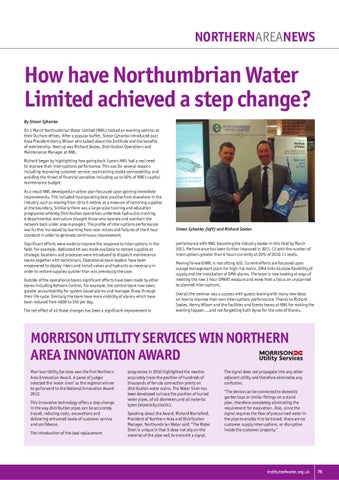NORTHERNAREANEWS
How have Northumbrian Water Limited achieved a step change? By Simon Cyhanko On 1 March Northumbrian Water Limited (NWL) hosted an evening seminar at their Durham offices. After a popular buffet, Simon Cyhanko introduced past Area President Henry Wilson who talked about the Institute and the benefits of membership. Next up was Richard Seales, Distribution Operations and Maintenance Manager at NWL. Richard began by highlighting how going back 3 years NWL had a real need to improve their interruptions performance. This was for several reasons including improving customer service; maintaining stable serviceability; and avoiding the threat of financial penalties including up to 50% of NWL’s capital maintenance budget. As a result NWL developed an action plan focussed upon gaining immediate improvements. This included incorporating best practise from elsewhere in the industry such as moving from 10 to 5 metres as a measure of restoring supplies at the boundary. Similarly there was a large scale training and education programme whereby Distribution operatives undertook hydraulics training. A departmental restructure brought those who operate and maintain the network back under area managers. The profile of interruptions performance was further increased by learning from near misses and failures of the 6 hour standard in order to generate continuous improvement. Significant efforts were made to improve the response to interruptions in the field. For example, dedicated kit was made available to restore supplies at strategic locations and processes were introduced to dispatch maintenance teams together with technicians. Operational team leaders have been empowered to deploy riders and install valves and hydrants as necessary in order to restore supplies quicker than was previously the case. Outside of the operational teams significant efforts have been made by other teams including Network Control. For example, the control team now takes greater accountability for system based alarms and manages these through their life cycle. Similarly the team have more visibility of alarms which have been reduced from 4000 to 350 per day. The net effect of all these changes has been a significant improvement in
Simon Cyhanko (left) and Richard Seales performance with NWL becoming the industry leader in this field by March 2011. Performance has been further improved in 2011-12 with the number of interruptions greater than 6 hours currently at 20% of 2010-11 levels. Moving forward NWL is not sitting still. Current efforts are focussed upon outage management plans for high risk mains, DMA links to allow flexibility of supply and the installation of DMA alarms. The team is now looking at ways of meeting the new 3 hour OFWAT measure and move from a focus on unplanned to planned interruptions. Overall the seminar was a success with guests leaving with many new ideas on how to improve their own interruptions performance. Thanks to Richard Seales, Henry Wilson and the Facilities and Events teams at NWL for making the evening happen….and not forgetting Kath Ayres for the vote of thanks.
MORRISON UTILITY SERVICES WIN NORTHERN AREA INNOVATION AWARD Morrison Utility Services won the first Northern Area Innovation Award. A panel of judges selected the ‘water siren’ as the regional winner to go forward to the National Innovation Award 2012. This innovative technology offers a step change in the way distribution pipes can be accurately traced, reducing costs, excavations and delivering enhanced levels of customer service and confidence. The introduction of the lead replacement
programme in 2010 highlighted the need to accurately trace the position of hundreds of thousands of ferrule connection points on distribution water mains. The Water Siren has been developed to trace the position of buried water pipes, of all diameters and all material types (especially plastic). Speaking about the Award, Richard Warneford, President of Northern Area and Distribution Manager, Northumbrian Water said: “The Water Siren is unique in that it does not rely on the material of the pipe wall to transmit a signal.
The signal does not propagate into any other adjacent utility and therefore eliminates any confusion. “The device can be connected to domestic garden taps or similar fittings on a stand pipe, therefore completely eliminating the requirement for excavation. Also, since the signal requires the flow of pressurised water in the pipe to enable it to be traced, there are no customer supply interruptions, or disruption inside the customer property.”
instituteofwater.org.uk
75
